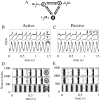Theta band zero-lag long-range cortical synchronization via hippocampal dynamical relaying
- PMID: 21408082
- PMCID: PMC3050931
- DOI: 10.1371/journal.pone.0017756
Theta band zero-lag long-range cortical synchronization via hippocampal dynamical relaying
Abstract
Growing evidence suggests that synchronization among distributed neuronal networks underlie functional integration in the brain. Neural synchronization is typically revealed by a consistent phase delay between neural responses generated in two separated sources. But the influence of a third neuronal assembly in that synchrony pattern remains largely unexplored. We investigate here the potential role of the hippocampus in determining cortico-cortical theta synchronization in different behavioral states during motor quiescent and while animals actively explore the environment. To achieve this goal, the two states were modeled with a recurrent network involving the hippocampus, as a relay element, and two distant neocortical sites. We found that cortico-cortical neural coupling accompanied higher hippocampal theta oscillations in both behavioral states, although the highest level of synchronization between cortical regions emerged during motor exploration. Local field potentials recorded from the same brain regions qualitatively confirm these findings in the two behavioral states. These results suggest that zero-lag long-range cortico-cortical synchronization is likely mediated by hippocampal theta oscillations in lower mammals as a function of cognitive demands and motor acts.
Conflict of interest statement
Figures





References
-
- Strogatz S. Sync. New York: Penguin Books; 2003.
-
- Pikovsky A, Rosenblum MG, Kurths J. Synchronization: a universal concept in nonlinear sciences. Cambridge: Cambridge University Press; 2001.
-
- Niebur E, Schuster HG, Kammen D. Collective frequencies and metastability in networks of limit-cycle oscillatorswith time delay. Phys Rev Lett. 1991;67:2753–2756. - PubMed
-
- Ernst U, Pawelzik K, Geisel T. Synchronization induced by temporal delays in pulse-coupled oscillators. Phys Rev Lett. 1995;74:1570–1573. - PubMed
-
- Reddy DVR, Sen A, Johnston GL. Time delay induced death in coupled limit cycle oscillators. Phys Rev Lett. 1998;80(23):5109–5112. - PubMed
Publication types
MeSH terms
LinkOut - more resources
Full Text Sources

